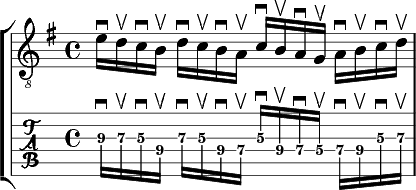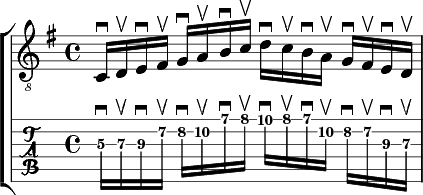Two string and three string alternate picking
Lots of ins and outs and whatnots
In this exercise you'll be playing 4 licks from the major scale and mostly practice switching strings when going from one string to another.
The point is to always alternate between downstrokes and upstrokes no matter where the notes take you. You will often find yourself playing a downstroke and switch to a higher string (moving your hand down, towards your legs) and you will have to play an upstroke, even though a downstroke would be faster. By doing this your right hand is in control of the rhythm - it's always doing up and down motions!
Be very carefull not to mess it up! If you do, try again, slower.
Two concepts - inside and outside picking are very important here. If you've heard it for the first time, read on:
Outside picking happens when you change to a higher string after a downstroke, or to a lower string after an upstroke. It's quite easy to imagine that if you were only to play these two notes on the stings your pick would be doing this kind of motion (if you're going from the D to the G string and vice versa):

Inside picking is just the opposite of that! This happens when going to a lower string after a downstroke or to a higher string after an upstroke. Here's a nice picture so you'll see what I mean:

Pattern 2
The first lick is all about outside picking. If you observe your right hand movement while doing this correctly, you will never see your hand picking pairs of strings from the inside.

The second lick combines inside and outside pickings - can you already see from the tabs which is which?

The third lick is really nice. The changes happen on the 4th, 3rd and 2nd note (and finally the 3rd again but from a different direction) of the 16th note groups. So you have outside picking, inside picking, followed by two outside pickings.

The final lick is just climbing up the scale and going back down. But watch how the going up and going down affects the string changes with regard to inside and outside picking.
